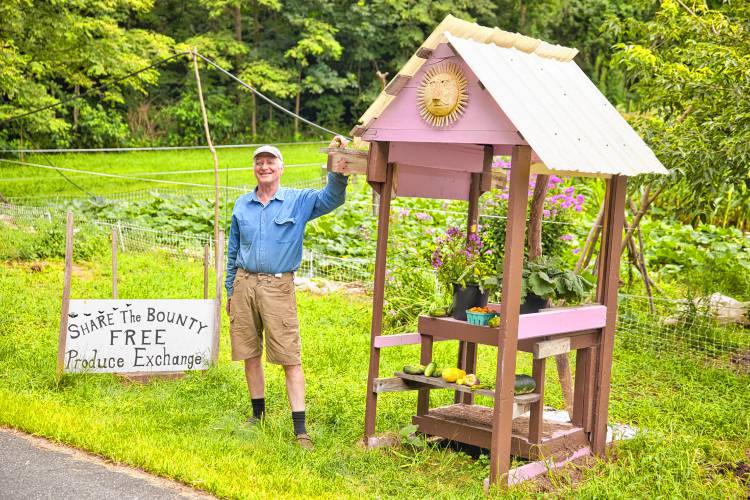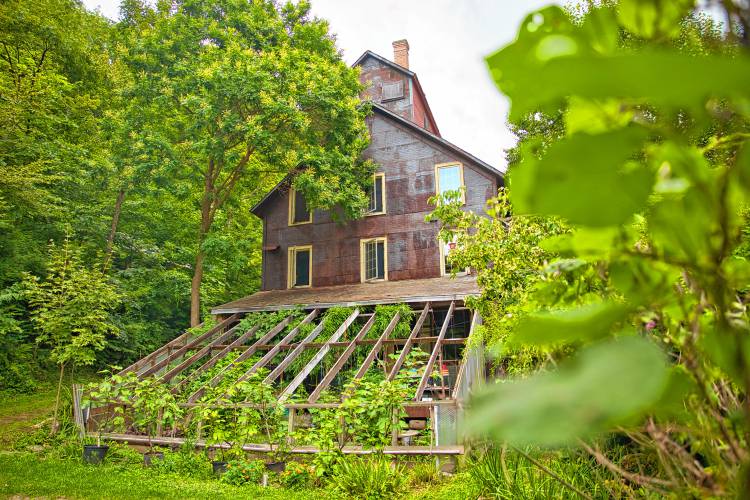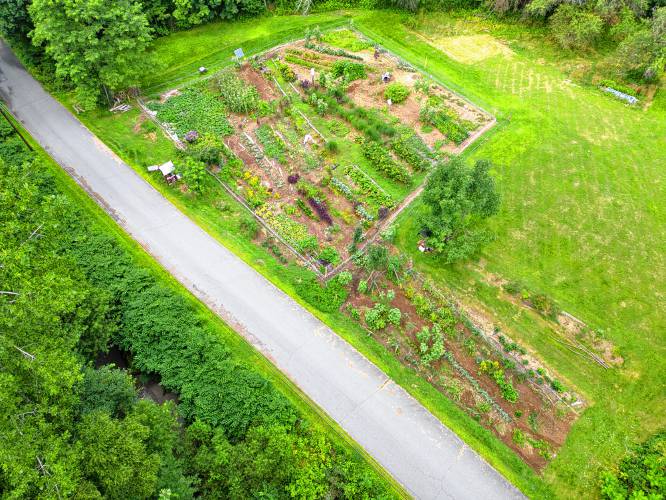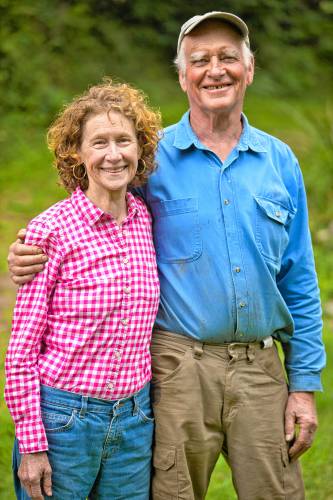Growing abundantly and sharing the bounty: Colrain resident’s garden is nothing short of magical
| Published: 08-26-2024 3:26 PM |
(Editor’s note: Last week’s column focused on the Colrain home of Jon Lagrèze and Judith Roberts; this week we learn about their garden.)
Jonathan “Jon” Lagrèze built his first farm structure before losing any baby teeth. At age 5 – after “borrowing” two chickens from a neighbor’s yard – the determined tyke banged together a coop using scrap lumber and tools he purloined from his father’s collection. Thus began his lifelong dream of farming.
Seventy years later, the Colrain resident lives in harmony with nature, observing weather patterns and growing an astonishing amount and variety of produce. Lagrèze and his partner Judith Roberts benefit from neighbors’ generosity; the couple’s third-of-an-acre garden is on adjacent property, and those passing the York Road parcel can admire the results of Lagrèze’s green thumb. They can also take (or leave) produce thanks to a pink kiosk adorned with a bright yellow sun and a sign inviting people to share the bounty.
“I’ve always been fascinated with food production,” said Lagrèze. In high school, he was president of his local 4H club and raised chickens and goats (obtained in reputable fashion). Later, while studying agriculture at Cornell, Lagrèze yearned to be “a 19th century New England Farmer,” yet found the academic program inclined toward agribusiness and turning out research scientists.
Lagrèze left Cornell and joined a farming commune called Dawes Hill. He helped start the farmer’s market in Ithaca, New York, which recently celebrated its 50th anniversary. “My friends and I were early supporters of Ithaca’s food co-op, and that’s still going strong, too.” Lagrèze’s siblings, Kate and Paul, were also part of the commune, and all three siblings now live in Franklin County, still pursuing dreams and projects rooted in love of the land. Paul Lagrèze is renowned for mushroom identification and production skills, and Kate Mason devotes her time to many community organizations.
After leaving the commune, Jon Lagrèze explored food production. “I grew alfalfa sprouts in gallon jars in my mother’s kitchen, launching Jonathan’s Sprouts, which is still in operation in Rochester. I went out on a fishing trawler to Georges Bank one year in February,” he said. “Later, Anders (Ferguson) and I took over the East Coast Kefir Company.” Those were just a few of Lagrèze’s endeavors.
Today, Lagrèze’s food production revolves around his garden. “When I lived in New York State, I knew a fellow who lived without electricity, a phone, or a car,” said Lagrèze. “He made his living growing and selling produce, and I thought he had the perfect garden. I always aspired to maintain a garden like his, and after 60 years, I think I’m getting close. Maybe it’s silly: it’s so much work, it’s way too big, and takes way too much time.” Yet Lagrèze’s mastery pays off. His sizable plot looks like a magician took a seed catalog, held it in the sky, and shook it so that every crop you can think of – and some you might not anticipate – fell down in picture-perfect fashion. If you’re a lifelong gardener visiting Lagrèze’s Eden, it’s tempting to resent the guy, but you simply can’t because he’s genuinely humble and magnificently generous.
This season, Lagrèze has put about 70 packages of produce in the freezer, with more to come. A quick garden tour reveals standard varieties: asparagus, onions, arugula and garlic. A grove of mint, Chinese cabbage, several types of berries and celery. Head this way, and you find pumpkin, beets and carrots. Over here are Brussels sprouts, cauliflower, broccoli, pole beans and cabbage. If you’re looking for squash, there are three types: butternut, sweet dumpling and delicata.
Article continues after...
Yesterday's Most Read Articles
Turn around, and there’s mustard, ground cherries, potatoes and corn. Pivot to find leeks, cukes, cilantro and parsnips. Beautiful flowers are everywhere, and birds sing like they’ve discovered heaven. Which they have.
There’s less common stuff, too. Tall hops plants tell the story of when Lagrèze made beer. Edamame is nearly ready to harvest, and there’s okra, amaranth and horseradish. Partridge peas, with leaves that delicately curl up at night, fix nitrogen into the soil. The sishu that Judith Roberts turns into a delicious beverage grows here, too. Back at the house are potted fig plants.
You may have rhubarb on your property, dear reader, but do you juice it, add other fruit juices and a natural sweetener, resulting in a mind-blowing treat? Yeah, me neither. But Lagrèze and Roberts do, and it’s just one of their dozens of adventures in the kitchen that Jon built within the shell of a former manufacturing space. (See last week’s column for a feature focused on architecture and history.)
Lagrèze’s sumptuous plot looks like a magazine cover. He gives a characteristic shrug. “I guess I weed a lot,” he said, pointing to two implements. One, called a wiggle hoe or scuffle hoe, was the go-to fav of my gardening mentor, Juanita Nelson (1923-2015). If Juanita had known about the other one – an implement Lagrèze made himself – she would’ve been over the moon.
Called a wire weeder, the tool consists of high-tensile fencing wire installed in a small loop at the tip of a long handle – in Lagrèze’s case, a piece of local ash formed into an elegant pole. “It’s even better than a scuffle hoe,” he said. “It’s lighter, and doesn’t hurt the plants. Plus, I saved $80 by making it myself.” Ingenuity and skill put Lagrèze head and shoulders above us amateurs. Another example is the solar-powered pump that brings water from Foundry Brook, which Lagrèze maximizes by orienting rows of crops on a slight slope so that he can “ditch irrigate.”
Lagrèze coordinates a seed-buying club; although he and farming pals engage in a good deal of seed saving, they also depend on good quality regional seed companies like Fedco. “Each year, about 25 of us purchase $2,500 worth of seed,” said Lagrèze. “That way, we get a 20% discount.”
A large greenhouse is part of the remodeled building Lagrèze and Roberts have called home for decades. For part of each year, the structure is covered in three layers of durable, inflatable plastic that’s 25-feet wide and 100-feet long. Having three layers not only stabilizes it, but also insulates well. “Snow slides off easily,” said Lagrèze, “but when there’s a massive amount of snowfall and there’s already a huge pile at the bottom, sometimes it has nowhere else to go.”
His DIY success also helps repel deer: “I heard about a barrier called 3D fencing, and made my own.” Lagrèze installed a strand of electric ribbon at about 30-inches high, a second strand two to three feet from the first at 24-inches high, and a third layer at 48-inches. “Deer won’t jump it because they don’t have good depth perception, and with eyes on either side of their head, they don’t feel confident about attempting it,” he said. Woodchucks, raccoons, and other shorter nuisances are discouraged by electric mesh that “so far no one has breached.” Not surprisingly, the system protecting this veritable Fort Knox of a garden is solar powered.
Despite astonishing accomplishments, Lagrèze diverts praise, paying tribute to his partner’s culinary prowess. “I’m the production guy, but Judith is a true food artist and amazing cook. Her skills are my inspiration and justification for growing so much food and putting it up.” Roberts, who retired from her position as executive director of The Literacy Project, also has a background in food production.
“The bounty of August is wonderful,” said Roberts, as she stirred ingredients in a pan. “I love making eggplant parmesan using tomato and basil from the garden.” She’s a vegetarian, while Lagrèze is not. “When we do buy meat,” said Roberts, “we buy it locally. We buy local beer, chicken, and eggs. I love making peach cobbler with Pine Hill peaches.” Grocery bills are fairly low, given Lagrèze’s output. “We barely buy fruits or vegetables,” said Roberts. “We have homemade melon popsicles in the freezer and we make huge salads.”
Lagrèze referred to a favorite made by his partner: “Judith makes a salad with sweet corn, cilantro, cukes, and tomatoes.” Roberts chimed in, “We can be creative. I’ve been making marjoram pesto, our new favorite.” Roberts and Lagrèze designed their kitchen together. “Jon wanted it slightly smaller, but I wanted to be able to cook with our kids, and all four have turned out to be fabulous cooks.”
When not cooking, Roberts stays busy. “At The Literacy Project, I learned so much from our courageous students and dedicated staff. That was the greatest honor of my career. Now, as a consultant, I support nonprofits and local businesses that make Franklin County a creative and vital place to live.” Roberts is also a disciplined lifelong athlete who bikes, swims, and participates in an annual triathlon. On top of all that, she co-facilitates FreeWrite at the Reentry Center, connected with the Franklin County Sheriff’s Office in Greenfield. “It’s an important writing group for women. I love that work, too,” said Roberts.
Paramount are the personal ties Roberts and Lagrèze nurture, maintaining connections with their children, step-children, grandchildren, and other loved ones. Everyone who stops by – for an hour or for a week – is fed by the output of this remarkable couple’s garden and the love that streams their warm hearts.
“I garden every day, sure,” said Lagrèze, “often putting in four to five hours. But I bounce around to other projects, too. I’m pretty random, like a robo-vac. I move around the property, thinking, ‘I better fix that, or maybe I’ll move that rock.’” His partner added, “Jon’s been moving rocks around here for years!” The two pause and look at each other with frank admiration. After 30-plus years, they still astound each other with their respective and combined talents in a gorgeous spot on Foundry Village Road.
Eveline MacDougall is the author of “Fiery Hope,” and an artist, musician, mom, and lifelong gardener. She enjoys hearing from readers at eveline@amandlachorus.org.










 Putting the students front and center: What can education can look like without high stakes testing?
Putting the students front and center: What can education can look like without high stakes testing? Sounds Local: He’ll play anything you want: Stephen Kellogg will perform an all-request show at Shea Theater, Dec. 19
Sounds Local: He’ll play anything you want: Stephen Kellogg will perform an all-request show at Shea Theater, Dec. 19 Speaking of Nature: Introducing the Birch Perch II: Making improvements to my bird observation venue
Speaking of Nature: Introducing the Birch Perch II: Making improvements to my bird observation venue Conversations over candy-making: Sharing beloved holiday food traditions
Conversations over candy-making: Sharing beloved holiday food traditions
